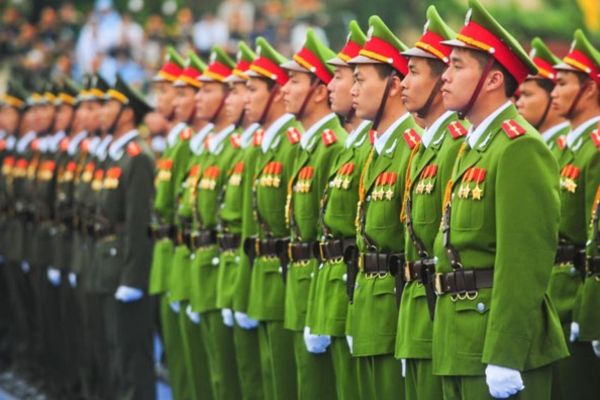From July 1, 2024, how will the salary scale for police officers change before and after the salary reform in accordance with Resolution 27?
From July 1, 2024, how will the police officer salary structure change before and after the wage reform according to Resolution 27?
Police officer salary structure before wage reform:
Based on the regulations in Section 1, Table 6 issued together with Decree 204/2004/ND-CP on salary coefficients for police officers.
Currently, the statutory pay rate is 1,800,000 VND/month (According to the regulations in Decree 24/2023/ND-CP)
The salary of police officers is calculated using the following formula:
| Actual salary = Statutory pay rate x Current salary coefficient || --- |
The salary structure for police officers is as follows:
| No. | Military Rank | Salary Coefficient | Salary (VND/month) || --- | --- | --- | --- || 1 | General | 10.40 | 18,720,000 || 2 | Senior Lieutenant General | 9.80 | 17,640,000 || 3 | Lieutenant General | 9.20 | 16,560,000 || 4 | Major General | 8.60 | 15,480,000 || 5 | Senior Colonel | 8.00 | 14,400,000 || 6 | Colonel | 7.30 | 13,140,000 || 7 | Lieutenant Colonel | 6.60 | 11,880,000 || 8 | Major | 6.00 | 10,800,000 || 9 | Captain | 5.40 | 9,720,000 || 10 | First Lieutenant | 5.00 | 9,000,000 || 11 | Second Lieutenant | 4.60 | 8,280,000 || 12 | Junior Lieutenant | 4.20 | 7,560,000 || 13 | Senior Sergeant | 3.80 | 6,840,000 || 14 | Sergeant | 3.50 | 6,300,000 || 15 | Corporal | 3.20 | 5,760,000 |
*Note: The salary mentioned above does not include allowances and salary increases according to regulations.
Police officer salary structure after wage reform from July 1, 2024:
On November 10, with the majority of deputies agreeing (94.33%), the National Assembly passed the Resolution on the state budget estimate for 2024.
Specifically, the Resolution states:
"From July 1, 2024, implement a comprehensive reform of wage policies according to Resolution 27-NQ/TW 2018 of the Seventh Conference of the Twelfth Central Executive Committee."
Thus, the National Assembly officially approved the wage reform from July 1, 2024, according to Resolution 27.
Additionally, in Resolution 27-NQ/TW of 2018, there is content regarding wage reform about constructing 03 new salary tables for the military and police according to job positions, titles, and leadership positions to replace the current wage system; convert old salaries to new salaries, ensuring not lower than the current salaries, including:
- 01 salary table for military officers, police officers, and non-commissioned officers working in the police force (according to positions, titles, and military ranks or police ranks);
- 01 salary table for professional military personnel and technical specialists in the police;
- 01 salary table for defense workers and police workers (maintaining the relative pay parity of the armed forces compared with civil servants).
Thus, after the wage reform, there will be a new salary table for police officers according to positions, titles, and military or police ranks.
*Note: As of now, the specific salary table for police officers has not been officially issued.

From July 1, 2024, how will the police officer salary structure change before and after the wage reform according to Resolution 27? (Image from the Internet)
What allowances will police officers receive after the wage reform from July 1, 2024?
Based on the spirit of Resolution 27-NQ/TW of 2018, the current allowance policies will be rearranged, ensuring the total allowance budget accounts for a maximum of 30% of the total salary fund as follows:
Contents of the reform
3.1. For officials and public employees and the armed forces (public sector)
...
d) Rearrange the current allowance policies, ensuring that the total allowance fund accounts for a maximum of 30% of the total salary fund.
- Continue to apply concurrent position allowances; over-frame seniority allowances; regional allowances; job responsibility allowances; mobility allowances; security and defense service allowances, and special allowances for the armed forces (military, police, cipher).
- Combine preferential occupation allowances, occupational responsibility allowances, and hazardous, dangerous allowances (collectively referred to as occupational allowances) applicable to officials and public employees in occupations and jobs with working conditions higher than normal and with appropriate State preference policies (education and training, healthcare, courts, procuracy, civil judgment enforcement, inspection, examination, auditing, customs, forestry, market management,...). Combine special allowances, attraction allowances, and long-term working allowances in areas with extremely difficult socio-economic conditions into allowances for working in extremely difficult areas.
- Abolish occupational seniority allowances (except for the military, police, and cipher to ensure relative pay parity with officials); leadership position allowances (as leadership positions in the political system will be salaried according to their positions); party work allowances, political-social organization allowances; public service allowances (as it has been included in the basic salary); hazardous and dangerous allowances (as the working conditions with hazardous and dangerous elements have been included in occupational allowances).
...
Based on the above content, after the wage reform, police officers will receive the following allowances:
- Concurrent position allowances, over-frame seniority allowances, regional allowances, job responsibility allowances, security, and defense service allowances; mobility allowances, and special allowances. Long-term occupational seniority allowances for the military and police;
- Combine special allowances, attraction allowances, and long-term working allowances in areas with extremely difficult socio-economic conditions into allowances for working in extremely difficult areas.
How many basic positions are there for People's Police officers?
Based on the regulations in Article 24 of the People's Police Law of 2018, the basic positions for police officers are as follows:
- Minister of Public Security;
- Director General, Commander;
- Director of Provincial Police, City Police under the central authority;
- Head of Department; Chief of District, Town-level Police, City under the province, City under the central authority; Regiment Commander;
- Head of Team; Chief of Commune, Ward, Town-level Police; Battalion Commander;
- Company Commander;
- Platoon Leader;
- Squad Leader.
LawNet